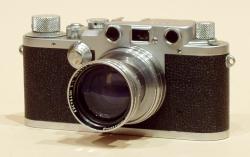|
|
The Leica IIIc is a top-quality rangefinder of the 40'.
 Made from 1940 to 1951, the Leica IIIc is the heir of a line of cameras with which the German manufacturer literally invented 35 mm photography in the hand of renowned photographers like Henri Cartier-Bresson. The one shown here, fitted out with a 50 mm f/2 Summitar lens, was made in 1950. This is the first Leica made of a one part die-cast body, making it much more rigid than its ancestors. The other characteristics remain the same than on previous models.
Made from 1940 to 1951, the Leica IIIc is the heir of a line of cameras with which the German manufacturer literally invented 35 mm photography in the hand of renowned photographers like Henri Cartier-Bresson. The one shown here, fitted out with a 50 mm f/2 Summitar lens, was made in 1950. This is the first Leica made of a one part die-cast body, making it much more rigid than its ancestors. The other characteristics remain the same than on previous models.
The Leica IIIc is a curtain-shutter rangefinder. Speeds are given by two dials, one on top for short speeds from 1/1000 s to 1/30 s and one on the front of the body for slow speeds down to 1 s. B and T pose are also available. The shutter cocking and film advance are made by a knob. The albada viewfinder and the rangefinder are separate but very close to each other.
The Leica IIIc accepts all Leica screw-mount (or LTM) lenses. Leica set the standard in this field, so a lot of lenses from different manufacturers are available : old ones (Leitz of course, but also Canon and Nikon, the latter having a very good reputation) as well as new ones made by Voigtländer for its Bessa bodies. One can thus put a computer-engineered aspheric lens on a 1940 body.
The Leica IIIc was followed by the IIIf on which flash-sync was added, and the IIIg with a much improved viewfinder with parallax indication. But the IIIc remains a real bargain for those wanting to use one of these marvels.
 |
Use |
|
 The Leica IIIc, along with the other cameras of the family, is a real jewel. Taking pictures with such a precious and sensual camera is paradoxally a new photographic experience in a world dominated by mass-produced plastic junk.
The Leica IIIc, along with the other cameras of the family, is a real jewel. Taking pictures with such a precious and sensual camera is paradoxally a new photographic experience in a world dominated by mass-produced plastic junk.
Of course, its ergonomics doesn't compare with modern cameras. Film loading is clumsy, though not as hard as some want to say it. The viewfinder is small but clear. The rangefinder is not visible in the viewfinder but in a different eyepiece. But the two eyepieces being placed very close together, they're quite convenient anyway (picture on the left : the rangefinder is on the left and the viewfinder on the right, along with a flash-sync plug added by the former owner of the camera). The knob winding, the two speed dials and and the lack of lightmeter make for a slow use.
On the bright side, it is very quiet. Without any mirror flipping up and down, the shutter goes off in a whisper. Its small size and elegance make it much less aggressive for the model than modern SLRs. Lightweight and very compact with its collapsible lens, it can travel in a pocket. It is never in need of batteries. The old lenses don't have the sharpness of modern ones but give a very interesting look to the pictures, and you can always buy modern ones.
With its perfect finish, the Leica IIIc is among those rare cameras with a soul which are almost as important as the photographer in the final picture.
 |
Characteristics |
|
Format |
24 x 36 mm on 135 film |
Lens |
interchangeable, LTM mount, coupled with the rangefinder |
Shutter |
curtain type, from 1/000 s to 1 s, without flash-sync (added afterwards by the former owner of the camera shown here) |
Exposure modes |
manual |
Weight |
640 g with the 50 mm f/2 Summitar |
 |
Sound |
|
 |
Accessories |
|
|
"Barndoor" folding Summitar sunshade |
|
|
WINTU right-angle viewfinder |
|
|
 |
Sample pictures
|
|
 |
Links
|
|
|